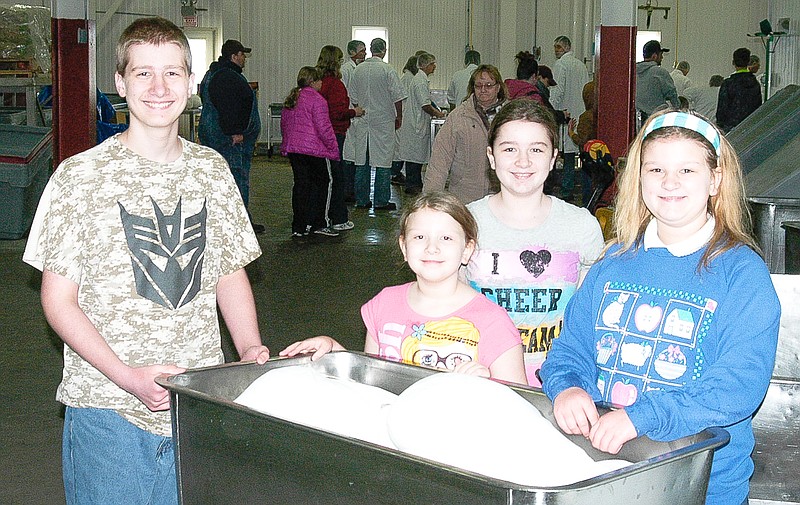Burger's Smokehouse swarmed with young people Saturday, Jan. 10. The 4-H and FFA students from around Central Missouri selected fresh hams to cure for either consumption or competition in one or more of the various fairs.
In preparation of the ham curing projects, 4-H and FFA youth gathered early at the facility on south Highway 87.
According to Steven Lehman of Burgers', about 700 hams were distributed for curing this year. The fresh hams average about 24 pounds each with the cured hams weighing in the 19-20 pound range.
The cured hams will be entered in the county fairs. Some will go on to be entered in the Missouri State Fair.
Each of the young people selects one or more hams, then begins the curing process by applying the "cure." a mixture of salts, brown sugar and black pepper. The hams are rubbed down with the mixture, with a few handfuls put on the meaty part on top.
The ham is then wrapped in butcher paper, placed in a stocking net (similar to cheese cloth) then hung on a rack. After about two months, the hams should be taken out of the butcher paper, put back in the net and hung up again. The curing process should be completed and the ham ready by the end of July, just in time for entering in the ham competition at the area fairs.
In addition to the various FFA chapters and 4-H clubs in Moniteau County, hams were selected by young people from a number of places, including Eldon, Marshall, Saline County, Jefferson City, Westphalia, Linn, Versailles, Russellville, Fayette and Lamar. Several students from Nichols Career Center FFA are curing hams, including Jean Hong, who is doing the "4 plus 1" which allows another year in FFA.
The youth from Morgan and Moniteau County usually leave the hams at Burger's, while those from more distant areas usually take them home to hang and cure.
Getting the youth started on ham curing is only one of the things the local business does for the extended community. But it is an important one, since it helps not only preserve hams, but also helps preserve the knowledge of how to preserve meat without the extensive use of modern technology.
Curing or preserving pork, primarily using salt, has been done for at least the last 4,000 years. Settlers from Europe brought the practice to the United States.
When E.M. Burger and his family began curing hams for their own use in the 1930s, they used a recipe for dry cure brought from Germany by his mother. Since extra hams could be sold, the family increased the number until a building was constructed for the purpose in 1952.
In the 63rd year of Burgers' Smokehouse, the company is known around the world for its meat products which are sold at the facility and in numerous grocery markets as well as via catalog and Internet sales.

